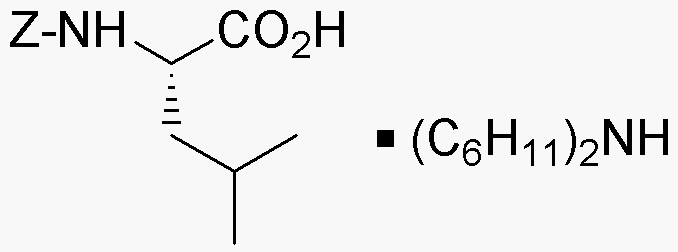Z-L-leucine dicyclohexylammonium salt is widely utilized in research focused on:
- Peptide Synthesis: This compound serves as a chiral building block in the synthesis of peptides, enhancing the efficiency and selectivity of reactions in pharmaceutical development.
- Protein Stabilization: It is used to stabilize proteins in various formulations, which is crucial for biopharmaceuticals, ensuring their efficacy and shelf-life.
- Drug Delivery Systems: The compound can be incorporated into drug delivery systems, improving the solubility and bioavailability of poorly soluble drugs, thus enhancing therapeutic effectiveness.
- Research in Metabolism: It is employed in metabolic studies to understand amino acid transport and metabolism, providing insights that can lead to advancements in nutritional science.
- Cosmetic Formulations: The compound is also found in cosmetic products, where it acts as a conditioning agent, improving skin texture and hydration.
General Information
Properties
Safety and Regulations
Applications
Z-L-leucine dicyclohexylammonium salt is widely utilized in research focused on:
- Peptide Synthesis: This compound serves as a chiral building block in the synthesis of peptides, enhancing the efficiency and selectivity of reactions in pharmaceutical development.
- Protein Stabilization: It is used to stabilize proteins in various formulations, which is crucial for biopharmaceuticals, ensuring their efficacy and shelf-life.
- Drug Delivery Systems: The compound can be incorporated into drug delivery systems, improving the solubility and bioavailability of poorly soluble drugs, thus enhancing therapeutic effectiveness.
- Research in Metabolism: It is employed in metabolic studies to understand amino acid transport and metabolism, providing insights that can lead to advancements in nutritional science.
- Cosmetic Formulations: The compound is also found in cosmetic products, where it acts as a conditioning agent, improving skin texture and hydration.
Documents
Safety Data Sheets (SDS)
The SDS provides comprehensive safety information on handling, storage, and disposal of the product.
Product Specification (PS)
The PS provides a comprehensive breakdown of the product’s properties, including chemical composition, physical state, purity, and storage requirements. It also details acceptable quality ranges and the product's intended applications.
Certificates of Analysis (COA)
Search for Certificates of Analysis (COA) by entering the products Lot Number. Lot and Batch Numbers can be found on a product’s label following the words ‘Lot’ or ‘Batch’.
*Catalog Number
*Lot Number
Certificates Of Origin (COO)
This COO confirms the country where the product was manufactured, and also details the materials and components used in it and whether it is derived from natural, synthetic, or other specific sources. This certificate may be required for customs, trade, and regulatory compliance.
*Catalog Number
*Lot Number
Safety Data Sheets (SDS)
The SDS provides comprehensive safety information on handling, storage, and disposal of the product.
DownloadProduct Specification (PS)
The PS provides a comprehensive breakdown of the product’s properties, including chemical composition, physical state, purity, and storage requirements. It also details acceptable quality ranges and the product's intended applications.
DownloadCertificates of Analysis (COA)
Search for Certificates of Analysis (COA) by entering the products Lot Number. Lot and Batch Numbers can be found on a product’s label following the words ‘Lot’ or ‘Batch’.
*Catalog Number
*Lot Number
Certificates Of Origin (COO)
This COO confirms the country where the product was manufactured, and also details the materials and components used in it and whether it is derived from natural, synthetic, or other specific sources. This certificate may be required for customs, trade, and regulatory compliance.

